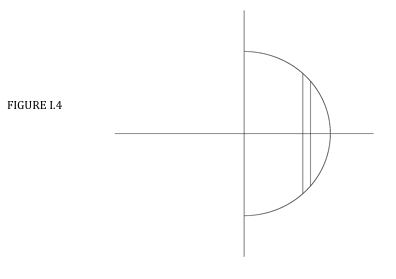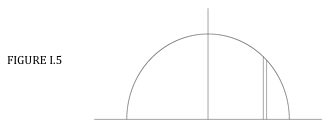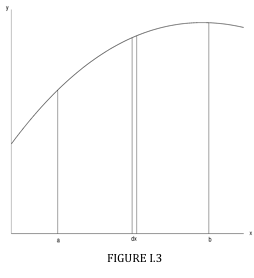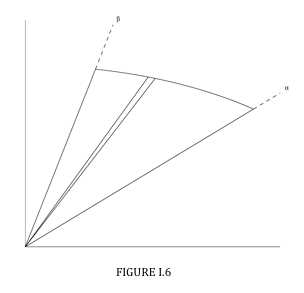1.3: Plane Areas
- Page ID
- 6927
\( \newcommand{\vecs}[1]{\overset { \scriptstyle \rightharpoonup} {\mathbf{#1}} } \)
\( \newcommand{\vecd}[1]{\overset{-\!-\!\rightharpoonup}{\vphantom{a}\smash {#1}}} \)
\( \newcommand{\dsum}{\displaystyle\sum\limits} \)
\( \newcommand{\dint}{\displaystyle\int\limits} \)
\( \newcommand{\dlim}{\displaystyle\lim\limits} \)
\( \newcommand{\id}{\mathrm{id}}\) \( \newcommand{\Span}{\mathrm{span}}\)
( \newcommand{\kernel}{\mathrm{null}\,}\) \( \newcommand{\range}{\mathrm{range}\,}\)
\( \newcommand{\RealPart}{\mathrm{Re}}\) \( \newcommand{\ImaginaryPart}{\mathrm{Im}}\)
\( \newcommand{\Argument}{\mathrm{Arg}}\) \( \newcommand{\norm}[1]{\| #1 \|}\)
\( \newcommand{\inner}[2]{\langle #1, #2 \rangle}\)
\( \newcommand{\Span}{\mathrm{span}}\)
\( \newcommand{\id}{\mathrm{id}}\)
\( \newcommand{\Span}{\mathrm{span}}\)
\( \newcommand{\kernel}{\mathrm{null}\,}\)
\( \newcommand{\range}{\mathrm{range}\,}\)
\( \newcommand{\RealPart}{\mathrm{Re}}\)
\( \newcommand{\ImaginaryPart}{\mathrm{Im}}\)
\( \newcommand{\Argument}{\mathrm{Arg}}\)
\( \newcommand{\norm}[1]{\| #1 \|}\)
\( \newcommand{\inner}[2]{\langle #1, #2 \rangle}\)
\( \newcommand{\Span}{\mathrm{span}}\) \( \newcommand{\AA}{\unicode[.8,0]{x212B}}\)
\( \newcommand{\vectorA}[1]{\vec{#1}} % arrow\)
\( \newcommand{\vectorAt}[1]{\vec{\text{#1}}} % arrow\)
\( \newcommand{\vectorB}[1]{\overset { \scriptstyle \rightharpoonup} {\mathbf{#1}} } \)
\( \newcommand{\vectorC}[1]{\textbf{#1}} \)
\( \newcommand{\vectorD}[1]{\overrightarrow{#1}} \)
\( \newcommand{\vectorDt}[1]{\overrightarrow{\text{#1}}} \)
\( \newcommand{\vectE}[1]{\overset{-\!-\!\rightharpoonup}{\vphantom{a}\smash{\mathbf {#1}}}} \)
\( \newcommand{\vecs}[1]{\overset { \scriptstyle \rightharpoonup} {\mathbf{#1}} } \)
\( \newcommand{\vecd}[1]{\overset{-\!-\!\rightharpoonup}{\vphantom{a}\smash {#1}}} \)
\(\newcommand{\avec}{\mathbf a}\) \(\newcommand{\bvec}{\mathbf b}\) \(\newcommand{\cvec}{\mathbf c}\) \(\newcommand{\dvec}{\mathbf d}\) \(\newcommand{\dtil}{\widetilde{\mathbf d}}\) \(\newcommand{\evec}{\mathbf e}\) \(\newcommand{\fvec}{\mathbf f}\) \(\newcommand{\nvec}{\mathbf n}\) \(\newcommand{\pvec}{\mathbf p}\) \(\newcommand{\qvec}{\mathbf q}\) \(\newcommand{\svec}{\mathbf s}\) \(\newcommand{\tvec}{\mathbf t}\) \(\newcommand{\uvec}{\mathbf u}\) \(\newcommand{\vvec}{\mathbf v}\) \(\newcommand{\wvec}{\mathbf w}\) \(\newcommand{\xvec}{\mathbf x}\) \(\newcommand{\yvec}{\mathbf y}\) \(\newcommand{\zvec}{\mathbf z}\) \(\newcommand{\rvec}{\mathbf r}\) \(\newcommand{\mvec}{\mathbf m}\) \(\newcommand{\zerovec}{\mathbf 0}\) \(\newcommand{\onevec}{\mathbf 1}\) \(\newcommand{\real}{\mathbb R}\) \(\newcommand{\twovec}[2]{\left[\begin{array}{r}#1 \\ #2 \end{array}\right]}\) \(\newcommand{\ctwovec}[2]{\left[\begin{array}{c}#1 \\ #2 \end{array}\right]}\) \(\newcommand{\threevec}[3]{\left[\begin{array}{r}#1 \\ #2 \\ #3 \end{array}\right]}\) \(\newcommand{\cthreevec}[3]{\left[\begin{array}{c}#1 \\ #2 \\ #3 \end{array}\right]}\) \(\newcommand{\fourvec}[4]{\left[\begin{array}{r}#1 \\ #2 \\ #3 \\ #4 \end{array}\right]}\) \(\newcommand{\cfourvec}[4]{\left[\begin{array}{c}#1 \\ #2 \\ #3 \\ #4 \end{array}\right]}\) \(\newcommand{\fivevec}[5]{\left[\begin{array}{r}#1 \\ #2 \\ #3 \\ #4 \\ #5 \\ \end{array}\right]}\) \(\newcommand{\cfivevec}[5]{\left[\begin{array}{c}#1 \\ #2 \\ #3 \\ #4 \\ #5 \\ \end{array}\right]}\) \(\newcommand{\mattwo}[4]{\left[\begin{array}{rr}#1 \amp #2 \\ #3 \amp #4 \\ \end{array}\right]}\) \(\newcommand{\laspan}[1]{\text{Span}\{#1\}}\) \(\newcommand{\bcal}{\cal B}\) \(\newcommand{\ccal}{\cal C}\) \(\newcommand{\scal}{\cal S}\) \(\newcommand{\wcal}{\cal W}\) \(\newcommand{\ecal}{\cal E}\) \(\newcommand{\coords}[2]{\left\{#1\right\}_{#2}}\) \(\newcommand{\gray}[1]{\color{gray}{#1}}\) \(\newcommand{\lgray}[1]{\color{lightgray}{#1}}\) \(\newcommand{\rank}{\operatorname{rank}}\) \(\newcommand{\row}{\text{Row}}\) \(\newcommand{\col}{\text{Col}}\) \(\renewcommand{\row}{\text{Row}}\) \(\newcommand{\nul}{\text{Nul}}\) \(\newcommand{\var}{\text{Var}}\) \(\newcommand{\corr}{\text{corr}}\) \(\newcommand{\len}[1]{\left|#1\right|}\) \(\newcommand{\bbar}{\overline{\bvec}}\) \(\newcommand{\bhat}{\widehat{\bvec}}\) \(\newcommand{\bperp}{\bvec^\perp}\) \(\newcommand{\xhat}{\widehat{\xvec}}\) \(\newcommand{\vhat}{\widehat{\vvec}}\) \(\newcommand{\uhat}{\widehat{\uvec}}\) \(\newcommand{\what}{\widehat{\wvec}}\) \(\newcommand{\Sighat}{\widehat{\Sigma}}\) \(\newcommand{\lt}{<}\) \(\newcommand{\gt}{>}\) \(\newcommand{\amp}{&}\) \(\definecolor{fillinmathshade}{gray}{0.9}\)Plane areas in which the equation is given in \( x-y \) coordinates
We have a curve \( y = y(x) \) (Figure I.3) and we wish to find the position of the centroid of the area under the curve between \( x = a \) and \( x = b \). We consider an elemental slice of width \( \delta x \) at a distance \( x\) from the \(y \) axis. Its area is \( y \delta x \), and so the total area is
\[ A = \int_a^b ydx \label{eq:1.3.1} \]
The first moment of area of the slice with respect to the \( y\) axis is \( x y \delta x \), and so the first moment of the entire area is \(\int_a^b xydx\).
Therefore
\[ \overline{x} = \frac{ \int_a^b xydyx }{\int_a^b ydyx} = \frac{\int_a^b xydyx}{A} \\label{eq:1.3.2} \]
For \( \overline{y} \) we notice that the distance of the centroid of the slice from the \(x \) axis is \( \frac{1}{2}y \) , and therefore the first moment of the area about the \(x \) axis is \( \frac{1}{2} y.y \delta x \) .
Therefore
\[ \overline{y} = \frac{ \int_a^b y^2dx }{2A} \label{eq:1.3.3} \]
Consider a semicircular lamina, \( x^{2} + y^{2} = a^{2} \) , see Figure I.4:

We are dealing with the parts both above and below the \(x \) axis, so the area of the semicircle is \(2\int_0^a ydx\) and the first moment of area is \(2\int_0^a xydx\).
You should find \( \overline{x} = 4a/ (3 \pi) = 0.4244a \).
Now consider the lamina \( x^{2} + y^{2} = a^{2} \) , \( y >0 \) (Figure I.5):

The area of the elemental slice this time is \( y \delta x \) (not \(2 y \delta x \) ), and the integration limits are from \( -a \) to \( +a \). To find \( \overline{y} \), use Equation \( \ref{eq:1.3.3}\), and you should get \( y = 0.4244a \) .
Plane areas in which the equation is given in polar coordinates.
We consider an elemental triangular sector (Figure I.6) between \( \theta \) and \( \theta + \delta \theta \) . The "height" of the triangle is r and the "base" is \( r \delta \theta \). The area of the triangle is \( \frac{1}{2} r^{2} \delta \theta \).
Therefore the whole area =
\[ \frac{1}{2} \int_ \alpha ^ \beta r^{2}d \theta \label{eq:1.3.4} \]
The horizontal distance of the centroid of the elemental sector from the origin (more correctly, from the "pole" of the polar coordinate system) is \( \frac{2}{3} r \cos \theta \) . The first moment of area of the sector with respect to the \(y \) axis is
\( \frac{2}{3}r\cos \theta \times \frac{1}{2} r^{2} \delta \theta = \frac{1}{3}r^{3} \cos \theta \delta \theta \)
so the first moment of area of the entire figure between \( \theta = \alpha \) and \( \theta = \beta \) is
\( \frac{1}{3} \int_ \alpha ^ \beta r^3 \cos \theta d \theta \)
Therefore
\[ \overline{x} = \frac{2 \int_ \alpha ^ \beta r^{3}\cos \theta d \theta }{3\int_ \alpha ^ \beta r^{2} d \theta} \label{eq:1.3.5} \]
Similarly
\[ \overline{x} = \frac{2 \int_ \alpha ^ \beta r^{3}\sin \theta d \theta }{3\int_ \alpha ^ \beta r^{2} d \theta} \label{eq:1.3.6} \]
Consider the semicircle \( r = a\), \( \theta = \frac{- \pi}{2}\) to \(\frac{+ \pi}{2} \)
\[ \overline{x} = \frac{2a \int_{- \pi /2}^{+ \pi /2} \cos \theta d \theta }{3 \int_{- \pi /2}^{+ \pi /2} d \theta } = \frac{2a}{3 \pi } \int_{- \pi /2}^{+ \pi /2} \cos \theta d \theta = \frac{4a}{3 \pi} \label{eq:1.3.7} \]
The reader should now try to find the position of the centroid of a circular sector (slice of pizza!) of angle \( 2\alpha \) . The integration limits will be \( - \alpha\) to \( + \alpha\).
When you arrive at a formula (which you should keep in a notebook for future reference), check that it goes to \( \frac{4 \alpha}{ 3 \pi} \) if \( \alpha = \frac{ \pi}{2} \), and to \( \frac{2 \pi}{3} \) if \( \alpha = 0\).




